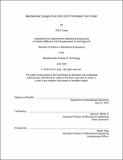Mechatronic design of an ISO 22675 prosthetic foot tester
Author(s)
Liang, ZhiYi,S.B.Massachusetts Institute of Technology.
Download1130237798-MIT.pdf (10.37Mb)
Other Contributors
Massachusetts Institute of Technology. Department of Mechanical Engineering.
Advisor
Amos G. Winter, V.
Terms of use
Metadata
Show full item recordAbstract
Researchers in the Global Engineering and Research Lab (GEAR Lab) at MIT have been actively working on an improved design of the most widely distributed prosthetic foot in India, known as the Jaipur Foot. By developing an ISO 22675 prosthetic foot life cycle tester, researchers in GEAR Lab can test the durability of the prosthetic designs and fulfill the life cycle requirements. This thesis explores the mechatronic design of an ISO 22675 prosthetic foot life cycle tester and its contribution towards establishing fatigue testing infrastructure for prosthetics in GEAR Lab. It is broken down into three sub-systems: mechanical design, electrical design, and control architecture. It also serves as a documentation file detailing the engineering design decisions that were made during the development of the project. By building upon a mechanical framework that was established by past researchers, mechanical redesigns were conducted on the force loading assembly and the pivoting loading platform. The redesigned mechanical assembly were tested to be able to sustain maximum test force level with a safety factor of at least 1.5. The redesigned structure also provides adjustability to four crucial geometric parameters specified by the ISO 22675 standard and enables testing of prosthetic foot ranging from 23 cm to 31 cm in length. In addition, a system control PCB was designed and developed to serve as an electrical communication hub for reliable communication between the host controller LabVIEW myRIO-1900, various sensors, and the two actuators responsible for applying the test force and rotating the loading platform. A control architecture was developed and implemented through a LabVIEW parallel timed loop control structure to execute the control loop at a rate of 1kHz to reliably control both the stepper motor and the servo in parallel, read sensor states and display system current real time state through a graphical user interface.
Description
This electronic version was submitted by the student author. The certified thesis is available in the Institute Archives and Special Collections. Thesis: S.B., Massachusetts Institute of Technology, Department of Mechanical Engineering, 2019 Cataloged from student-submitted PDF version of thesis. Includes bibliographical references (pages 85-86).
Date issued
2019Department
Massachusetts Institute of Technology. Department of Mechanical EngineeringPublisher
Massachusetts Institute of Technology
Keywords
Mechanical Engineering.